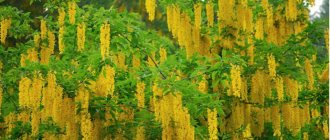Category: For the garden Reading time: 11 min · Views: 13,614
Willow is a beautiful tree in itself. But it will gain real charm only after pruning and a special haircut done by professionals. People in this profession are called arborists. Knowing the developmental characteristics of different tree species, they can calculate where the growth of branches will be directed after pruning, and what effect the skeletal branches will have on the shape of the crown and its size. And at the same time they can make such a “haircut” so that the crown of the tree forms a dome of branches and leaves, and inside there is free space in the form of a gazebo.
General characteristics of the shrub
The plant belongs to the willow family and is correctly called bredina. Among the people, the tree received its name because its foliage became the favorite food of goats and sheep . Another common name is rakita. Throughout the year, the tent-shaped weeping shrub looks very attractive: soft seals cover the shoots in the spring, which are then filled with dense foliage and beautiful yellow flowers until autumn; in winter, against the background of snow, even bare shoots from greenish-gray to red-brown color attract attention.
The tree has an average size of 3 to 10 meters in height and a powerful, branched root system. The homeland of pendula is Europe, but it has taken root well in many other parts of the world, including Russia. Life expectancy is on average 30−40 years, but sometimes reaches 150 years. The shoots are long, weaving, cascading down to the ground - this is precisely what is of decorative value in goat willow.
Types of nonsense
Botanists classify the plant as a tree or tree-like shrub. Loves light, unpretentious in the choice of soil. Today, the following varieties of goat willow are distinguished:
- Pendula - reaches about 3 m in height, characterized by a wide weeping crown, dark green foliage, elliptical shape 8-10 cm. Looks great on a trunk. Life expectancy is short - up to 30 years. Loves abundant watering, takes root in any soil, especially well near water bodies. It fits perfectly into the landscape both alone and in a group. The proximity of conifers decorates the composition. In care, pruning of shoots is important; only proper formation of the bush in the first year of life will create the required exterior.
- Kilmarnock is a miniature tree, its height is only 1.5 m. It loves light, tolerates frost well, and grows on any soil. Does not like excess moisture; watering should be moderate.
- Mas - has a spreading crown and reaches 10 m in height.
Popular varieties of willow on a trunk
Willow whole-leaved Pendula (Pendula)
on a trunk has a weeping crown shape. The pinkish young leaves turn green quite quickly, and in the fall they acquire a pleasant orange-yellow hue. They have an oblong shape with a sharp tip and usually grow up to 15 centimeters in length. This willow variety is quite winter-hardy and wind-resistant, and tolerates sudden temperature changes. It grows and develops best in a sunny location in sandy or peaty soil. The growth rate of shoots is small - about 20 centimeters per year, but this variety must also be trimmed to thicken the crown and increase the decorativeness of the entire plant.
Iwa Hakuro-Nishiki
on the trunk it is quite vigorous with long shoots growing upward, so that, even with strong spring pruning, you will be pleased with its thick and fairly wide crown (up to three meters in diameter) all season long. The young leaves of this willow also have a pinkish tint and then turn white-green. Hakuro-Nishiki looks very advantageous against the background of plants with a monochromatic dark color. To plant this variety of willow, you also need to choose a sunny place, and add sand and peat to the planting hole if the soil is clayey.
Purple willow Nana
on the trunk it has thin, erect shoots that bend closer to the tips under the weight of dense foliage. The densely growing light green leaves have a narrow oblong shape and grow up to fifteen centimeters in length. This type of willow got its name thanks to the purple catkins that appear on the shoots even before they become covered with leaves. Nana is smaller in comparison to Hakuro-Nishiki and will be up to two meters in diameter. It should also be planted in a sunny area with moist and loose soil.
Goat willow Pendula
on the trunk, thanks to branched, flowing shoots strewn with oblong, but more rounded leaves, it has a rather thick and fluffy crown of an elegant shape. It looks incredibly beautiful in the spring, when the shoots are literally strewn with large silver earrings. The leaves are matte green on the front side, and slightly silver on the back. Among the weeping forms, goat willow on a trunk is most often used in landscape compositions due to its high decorativeness and absolute unpretentiousness. Don’t forget about annual pruning and sufficient moisture, then this beautiful standard tree will be one of the main decorations on your site for many years.
Goat willow Curly Locks
the trunk is pleasing to the eye with unusual twisted shoots that, twisting, fall to the very ground. Thanks to this, this variety of willow will be decorative at any time of the year. Unlike other varieties, Curly Locks can grow in partial shade, but it does not like strong winds, so this willow should be planted in the most windless place possible: near a house, a fence or near a hedge. Covered with small bright green leaves, which by autumn become a pleasant yellow hue, the twisting shoots look very decorative.
Willow hybrid Mayak
on the trunk it is notable for its red, very flexible shoots growing in the shape of a fountain. The small leaves are light green, slightly silvery and have a narrow oblong shape. The crown grows up to 2.5 meters in diameter. Like other willows, it prefers fertile, moist soil and grows most actively in sunny areas. To maintain a decorative appearance, spring pruning is recommended, then the fluffy and dense spherical shape will be attractive all season.
Standard willows are gaining popularity every year and are increasingly used by landscape designers in both minimalistic and complex compositions. Unpretentious beauties attract attention and remain decorative throughout the season, thanks to their standard form and unusual shoots and foliage.
1491
Share on social networks:
Tree propagation and cultivation
Propagated by seeds, grafting and cuttings. Seeds must be used after 10 days of ripening, otherwise germination is lost. Flowering begins in April with golden earrings about 10 cm long and lasts about 2 weeks. In May the fruit is formed. It has the shape of a box measuring 8 cm, which contains up to 20 seeds with fluffy growths.
It is easier to root a tree by cuttings. To do this, cut branches at least 10 cm long should be placed in a bucket for several days. It is necessary to make good drainage in the hole , fertilize it with compost, place the cutting, bury it and provide abundant watering.
The crown should be formed immediately by cutting off the lower branches; the growth bud should always be directed outward.
Not every gardener can graft onto a standard tree. This is a rather complex process that requires certain knowledge and skill. Goat willow on a trunk does not take root in all varieties. Pendula is best suited for this. The original trunk can also be used as a standard. Subsequently, you need to monitor the kidney very carefully so that it does not appear below the grafting site. If this happens, then the kidney must be removed.
The best option would be to purchase a ready-made seedling from a nursery. When purchasing, you need to carefully check the tree to ensure it is healthy. The bark should be solid without cracks, and there should be no dead scales.
Soil preparation and watering
Bredina is not picky about the soil and will take root well in almost any conditions. But it will feel best on loamy soil, which is dense and retains moisture well. In spring, for planting you will need a hole 40 cm deep and 50 cm wide (to fit the entire root system). At the bottom of the hole you need to make good drainage, then fill 1/3 with earth or better such a mixture; Combine compost, humus and peat in a 1:1 ratio; you can also add a little sand. For growth, feed with nitrogen fertilizer, then place the seedling in the center and bury it.
After watering abundantly, a young tree will need about 25 liters of water per week. To reduce moisture evaporation, it is recommended to make a layer of mulch near the trunk. To do this, you can use the following materials: sawdust, pebbles, expanded clay, peat, dried grass, paper. also need regular hilling , which will saturate the plant with oxygen and the soil will not crack.
Decoration of a summer cottage goat willow
Goat willow, otherwise botanists call it Bredina (Selix carrea), and in common people it is simply Rakita, a plant belonging to the Willow family.
Europe is considered its homeland, but it grows successfully in Western Asia, the Caucasus and Central Asia. The average life expectancy is 150 years. During this time, the height of the plant can reach 10 m and 0.75 m in trunk diameter. Many gardeners wonder whether goat willow is a tree or a shrub? Everyone calls it differently, but in general classification it is a deciduous tree, sometimes a tree-like shrub. Based on the name, we can conclude that sheep and goats like to feast on the plant.
The main points of grafting
What rules must be followed in order to grow a beautiful standard tree that is pleasing to the eye and harmoniously fits into the design? Here's a quick step-by-step guide:
- Grow the base (or standard). The young seedling is tied to a support and allowed to develop to a certain height.
- Take a healthy cutting with two to four living buds.
- Make an oblique cut above the upper bud of the cutting (scion), and in the lower part, using two cuts, create something like a wedge.
- Using a pointed section (wedge), carefully insert the scion into the trunk so as not to damage the latter.
- Treat the junction area with garden varnish and tie it with a plastic bandage or electrical tape, which can be replaced with new ones over time, and after a year completely removed.
- After a month, the cutting should take root and new buds will appear on it. Freshly baked shoots will soon form, and as soon as they grow twenty centimeters, they will need to be pinched properly.
Short description
The plant loves light, however, it has shade-tolerant qualities. Favorite growing areas: fertile, rich, sandy or gravelly soils. At the same time, they should not be very wet - this can destroy the tree. As a conclusion, watering should be moderate. Broom is found along roads, houses, in forest clearings, and clearings. Formed seedlings are used for planting. If you need to propagate, then cuttings, seeds or a grafting method are suitable for this.
The characteristic features of the plant are:
- Branches . They are thick and spreading. In young individuals they have a slightly grayish color and slight pubescence. In mature and well-developed specimens, the color of the branches may be greenish-gray or yellow-brown. If the tree is old, then its branches become gray in color and become brittle.
- Bark. At first it is green-gray in color and quite smooth. As it matures, the color changes to brown, and cracks form at the bottom of the trunk. As for wood, it is smooth, but when it comes into contact with air it turns red.
- Foliage. It has an elliptical shape with a length/width of 11-18/5-8 cm, respectively. The outer side is dark green, and the lower side is grayish. A distinctive feature is a jagged, uneven edge. The buds are hidden in the axils of the leaves. They are quite large (length-width 5/3 cm, respectively). Flower buds are reddish in color and ovoid, not flattened, measuring 15/3-6 mm in length/width.
- Flowers in the form of earrings. Goat willow blooms in April, before the foliage begins to grow, and lasts 10-13 days. There are female and male flowers. The first are wide, oblong-oval, up to 6 cm long. The second are dense, cylindrical, reach 10 cm in length, multi-flowered.
- Fetus. As a result of pollination in May, a fruit is formed in the form of a box with a diameter of about 7-8 cm, located on a fluffy petiole. Each fruit contains about 18 seeds with fluffy outgrowths, thanks to which the seeds are transferred over a distance. Unfortunately, the seeds lose their viability very quickly.
Description of willow with photo
Fast-growing and easy to grow, deciduous willows can take on a variety of forms depending on the growing area - from dwarf and creeping shrubs to large, stately trees.
Blooming garden willow
Willow leaves are most often narrow, lanceolate, but can also be elliptical or almost round, smooth or slightly pubescent. In spring, plants are attracted by decorative fluffy male inflorescences-catkins, popularly known as “seals”.
Some inflorescences are very large, almost 6 cm in length. They can be golden, reddish or silver in color, depending on the variety of willow. Willow flowers are honey-bearing. Willow is one of the earliest flowering plants, and its pollen and nectar are the first food for bees after winter.
Due to the ability to form adventitious roots, the plant is very easily propagated using cuttings, but the seed material is viable for only a few days, after which the seeds lose their viability.
Beauty and form
Goat willow in landscape design (photo can be seen below) is very common. And all thanks to its beauty and shape. Moreover, the appearance of the plant greatly depends on the soil in which it grows and the light level.
Most often, broom is planted when landscaping private houses and estates. At first glance, the willow seems unprepossessing, but thanks to its weeping forms, grafted onto the trunk, it acquires a very attractive appearance.
Willow also looks great in rocky gardens, as well as on the edge of ponds. It is worth appreciating another advantage of the plant - the ability to hold the soil together with its roots, so it is not surprising that it is often planted on slopes.
Grafting a standard tree
The grown plant is the optimal rootstock for many plants. The selected scion should be stronger both in terms of genetic indicators and vegetation. Read this article about rootstock and scion.
For example, pear - rowan, cedar - pine.
to graft standard trees in the spring, at the very beginning of the plant’s awakening. And how to do it correctly is described here.
Fig.3 Standard tree
Select a scion cutting with several buds. Vaccination activities must be carried out strictly in compliance with agricultural technologies. Read more about garden grafting here. The results of the work will be visible only in a month to a month and a half. The active awakening of the buds and the growth of young shoots is an opportunity to smile and rejoice in victory.
If desired, the plant can not be grafted. Having chosen one central shoot, gradually prune away excess branches. This is a simple but time-consuming method.
The area near the standard tree can be improved. This way the handsome miniature will look even more attractive. Add a small green lawn similar in color to the plant's foliage. The result will exceed expectations.
You can see how to form a standard by blinding the buds in this video.
Garden decorating and landscaping is a fun activity that allows you to beautify the world around you. However, few gardeners know about such a plant as goat willow. Easy to care for, looks great in any season - such a specimen is a must-have in the garden.
Varieties
Most often, gardeners pay attention to such varieties of willow as “Silberglanz”, which has a height of up to 8 m and a spreading crown, “Pendula”, the main advantage of which is a weeping crown and standard form, and “Mas”, which has a wide spreading crown and reaches a height of up to 10 m.
Goat willow Pendula
This is a deciduous tree, reaching a height and length of up to 2-3 m. As a rule, it lives no more than 30 years on soils of any moisture content. The variety is shade-tolerant and light-loving. For normal growth, abundant watering is required. But to avoid overflowing, a fairly high drainage layer should be laid. The plant is frost-resistant, but it is recommended to cover the trunk for the winter.
Formation of a plant trunk
It is better for novice gardeners not to undertake the complex formation of a trunk. You should start with the usual pruning of the growing crown and shaping the trunk of the plant.
1. When choosing planting material, pay attention to the trunk of the plant; there should be no knots or bends on it. It’s impossible to align them; the result is zero attractiveness.
2. Drive a strong stake or other support next to the planted tree; it is necessary to fix the crown of the plant. Monitor the growth of the plant and trim the side shoots in a timely manner.
3. Once the tree has reached the desired size (ideally no more than 1.5 m), remove the top.
4. We begin to grow the crown by pinching young shoots. The procedure interval is at least once a month. Depending on the growing season, the process can drag on for a period of six months to one and a half years. There is no need to be afraid, the work is not labor-intensive, but the voluminous, dense crown will please the eye.
Fig.2 Standard tree
Goat willow: planting and care
Planting is carried out with the onset of spring. The cuttings are placed in water in advance and wait until the roots appear. Afterwards, they should be transplanted into open ground, after digging a shallow hole. The extracted soil is mixed with compost, and after planting the cuttings are poured into the hole and the soil is slightly pressed down. Afterwards, water the plant well. Subsequently, watering is performed 2-3 times/week. For adult specimens, regular watering is not necessary. If the weather is dry and hot in the summer, the seedlings should be watered more often.
As for feeding, in the spring-autumn period it is carried out twice using complex means. In autumn, give preference to potassium sulfur or superphosphate. If there are a large number of weeds around the tree, mulch with sawdust, peat, expanded clay, paper, and crushed pebbles.
If the soil near the goat willow dries out quickly, loosening should be carried out, and if cracks appear, the soil should be watered first and then loosened.
Don’t forget about timely and regular tree trimming.
Proper planting, watering control, and pruning will help you form a beautiful plant that will add grace to the landscape design of your home.
Getting to know goat willow - video
Weeping forms of trees. Pruning, crown formation
Probably every summer resident dreams of a tree that will be the accent of the entire garden, decorative all year round. It can be a tree with a weeping form. It looks amazingly elegant and romantic and delights you with flowers in spring, a cascade of leaves in summer, bright colors of leaves and fruits in autumn, and beautiful branches in winter.
Weeping trees are especially impressive near ponds or in a Japanese garden (where a weeping willow or maple is an integral element of the garden, setting the mood). They can be a wonderful backdrop for a flower garden, form romantic alleys, or serve as a shady, cozy canopy for a bench.
Willow planting
- step 1 . If you decide to grow the regular version of goat willow, propagation involves taking cuttings and placing them in water for a couple of weeks, then planting them in pots to allow the young shoots to take root. If you need a seedling on a standard, it is best to purchase it from a nursery to be sure that the graft has taken root;
- Step 2. Select the optimal disembarkation time. Early spring is best, when the soil has warmed up and the buds have not yet opened. You can plant it in the fall, but in the summer the tree may take root poorly and get sick due to the heat
- step 1 . Choose a location for the willow tree. This should be a moderately shaded area. But this variety grows well in the shade, although it develops more slowly without sunlight. The distance to the fence and neighboring trees depends on the type and size of the mature tree;
- step 2 . Dig a hole for the seedling. The diameter should be about 60 cm, the depth - about half a meter. Place a drainage layer 15–20 cm thick at the bottom. Use expanded clay or crushed stone
- step 1 . Prepare a nutrient mixture of 2 parts humus, 2 parts turf soil and 1 part sand;
- step 2 . Fill most of the hole with the prepared mixture. Carefully remove the seedling from the container, try to damage the earthen ball as little as possible;
- step 3 . Make a small hole and plant the plant at the desired level. Fill the nutrient mixture to the top of the hole;
- step 4 . Compact the surface. There should be a depression around the trunk so that water collects there and the root system does not suffer from lack of moisture
- step 1 . Pour 1-2 buckets of water and wait until it is completely absorbed;
- step 2 . If the moisture was absorbed slowly, add another bucket of water, if quickly, then at least 2 more buckets. Mulch the surface with black soil or peat so that water evaporates more slowly;
- step 3 . Water the plant 2-3 times a week for a month after planting
Using willow as a garden decoration
A low-growing bush willow, not exceeding 1.5 m in height, is more suitable for garden decoration. A weeping willow or one with a spherical shape gives no less of a decorative effect. It will be useful to know that bush forms of willows tolerate frosts better, unlike other varieties.
Since ancient times, willow twigs have been a natural material for creating decorative elements in a garden or personal plot.
Wicker furniture, household utensils or hedges can add personality to the landscape, but a special effect can be achieved by using willow cuttings. By growing them and gradually adjusting them and setting the direction, you can create:
Pruning the climbing willow is a desirable procedure.
If a tortuous willow seedling has found a place in your garden plot, then you should familiarize yourself with the rules for caring for it and methods of propagation.
Care and reproduction
The first thing to take into account is that willow trees and shrubs love moisture. For this reason, they are planted near water bodies and in well-lit places. All of their species are not picky tall-growing plants. By choosing the right place, you can avoid being too distracted by care.
Most of them are actively growing and taking root without problems. But for propagation it is better to select young branches.
Reproduction and full development of the twisting willow is possible in moist soil. In the summer, the curly willow will amaze with its foliage and curved shoots, and in the winter with its twisting branches under the snow covers.
Willow twigs remaining after formative pruning may be quite suitable for propagating twisted willow. Such cuttings can be immersed in water and wait for roots to appear, or they can be immediately immersed in the ground. An important condition for rooting is the moist state of the soil.
There is also no need to rush to feed the twisting willow. The tree should be allowed to gain strength.
Pests do not bother this type of tree too much. But, having provided the shoot with traditional care, it should be protected from severe frosts. Sometimes the branches freeze slightly at low temperatures, but after some time the crown is successfully restored.
Having provided the twisting willow with two main conditions for successful development - the crown in the sun and the roots in moisture, you can practically stop caring for it.
Goat willow care
- spring and autumn . If there is no precipitation, water the plant once every 2 weeks. If it rains periodically, there is no need for watering;
- summer . In hot weather, watering is done twice a week. If it rains from time to time, the frequency of watering decreases.
- spring . Fertilizing is carried out immediately after the soil warms up. Any complex fertilizer suitable for willow is applied. If it can be diluted with water, then do so, as the nutrients will reach the root system much faster;
- summer . Feeding is done in mid-June. It is not worth doing it too late, since this type of willow intensively sends out young shoots and if they grow until autumn, they will not have time to get stronger and may freeze in winter.
- spring . The trunk circle is loosened and the shoots are cut to approximately 2/3 of the length. This allows you to form a thick and neat crown;
- summer . Loosening and pruning are carried out as necessary;
- autumn. After loosening in October, it is advisable to mulch the soil with a 10 cm layer of peat to protect the roots from the winter cold
- diseases. The most common spots found on goat willow are white and black spots. This is a fungal disease that can be prevented by treating the crown with fungicides twice a season - in spring and autumn;
- pests _ Most often, willow is damaged by the flower fly shown in the photo. To combat it, use special compounds sold in flower shops. And to kill the larvae, treat the tree trunk circle with a solution of potassium permanganate
Let's get treatment!
If you decide to grow something in your garden that cannot be seen in everyone, then Pendula goat willow is ideal for you. Diseases and pests are the only things that can mar cultivation, but diseases can also be combated.
Let's look at what pests and diseases willow is exposed to:
- Willow leaf roller. Harms the tree at the larval or caterpillar stage. To get rid of the insect, you can spray the willow with chemicals that are available for sale in specialized stores.
- Flower fly. First you need to find the place where the larvae live. Remove the top layer of soil; if they are located there, you will immediately find them. You can remove flies by watering the soil with a weak solution of potassium permanganate. If it doesn’t help, then insecticides will come to the rescue.
- Powdery mildew. This is a representative of a fungal disease that reproduces at a high rate. Bad leaves need to be removed promptly. You can spray with a drug whose action is aimed at combating fungal diseases. It is recommended to replace part of the soil under the tree.
- Black spot. To avoid it, you need to reduce the contact of leaves with water. It is sometimes difficult to do this outdoors, so choose places where the breeze will constantly blow on the willow. Timely weeding and removing debris under the tree helps combat black spots.
Properly protect the plant from scab
- From heavy rains in spring or autumn, willow can become infected with scab . It’s easy to identify the problem - the crown looks like it’s been burned by fire. You need to fight the disease like this: all damaged shoots are cut off and burned, and do the same with fallen leaves. Treat the damaged areas with copper sulfate and cover with oil paint.
Natalia Semenova:
Stone_Pine, it looks like a fungal disease. It might be willow scab. Many types of willows are susceptible to it, especially weeping forms. Rains in spring and autumn contribute to the disease. With massive scab damage, the crowns of diseased trees take on the appearance of being scorched by fire.
In the spring, after the leaves bloom, a dark olive coating forms on the upper side of the leaf blades, consisting of mycelium (mycelium) and sporulation of the pathogen. Affected leaves turn black and die. From here the mycelium penetrates into the shoots. They turn black, become deformed and die.
Now remove all affected branches and burn them. In the fall, collect all the foliage and burn it. After removing diseased branches, be sure to treat the wounds with 1-3% copper sulfate and then it is advisable to cover them with oil paint based on natural drying oil. Spray the plant with fungicides now and in early spring. And in the spring, starting 10–14 days after the leaves bloom, with an interval of 2–3 weeks, spray the willow with fungicides 3–5 times.
- Do not plant goat willow on a trunk in regions with cold winters . Only the usual unvaccinated options are suitable there.
Dune HD:
Please tell me, will the goat willow Pendula (Kilmarnock) live on the trunk in Novosibirsk? Or is it better not to try and not torment the plant?
Mountelf:
Caring for the plant
Basic tree care includes:
- Watering. In the first year of life, this willow variety needs plenty of moisture. The Weeping Beauty should consume about 50 liters of water in two weeks. If the summer is too dry, then this volume is lost in a shorter period of time. For the second, third and subsequent years, one irrigation is sufficient, which can be carried out every week.
- Fertilizer. During the entire period from early spring to autumn, you need to feed the willow two or three times. Complex mineral fertilizers are suitable for this. In September, the tree is fed with superphosphate or potassium sulfur. If a dark coating appears on the leaves, then copper oxychloride is used for treatment.
- Mulching. It helps retain moisture and stop weed growth. Peat, paper, sawdust, expanded clay or pebbles are ideal for this. All this material is crushed and scattered under the tree on top of the soil.
- Loosening. If the soil under the plant is too dry and cracks have formed, they need to be removed. To do this, loosen the soil a day after watering.
- Preparing for winter. This stage in care is also significant. In order for the plant to survive our harsh winter well, the trunk is wrapped with covering material. This procedure is used for trees under three years old.
We looked at how to properly care for a plant such as Pendula goat willow. Pruning is another main type of care that we will pay special attention to.
What to remember
- Goat willow is an unpretentious plant that grows in the shade and does not tolerate standing water in its roots.
- Planting consists of selecting a seedling, preparing a hole, filling it with a nutrient mixture and abundant watering.
- Care consists of periodic watering, fertilizing, pruning shoots, loosening the soil and treating against pests and diseases.
Video: goat willow on a trunk. Kilmarnock
Sources:
https://sotka.guru/derevya/ukrashenie-sada-kozya-iva-na-shtambe.html https://glav-dacha.ru/ukrashenie-dachnogo-uchastka-iva-kozya/ https://qlumba.com /dekorativnye-rastenija/25-iva-kozya
Possible problems when cultivating the crop
According to experts, the culture is resistant to most diseases. However, their manifestations are periodically observed on willow. Unfortunately, diseases are not the only problems that arise when cultivating willow. The most common problems:
- Diseases. The appearance of a white coating on the foliage signals that the tree is infected with powdery mildew, the causative agent of which is a fungus that infects the leaf plates located below the crown. Over time, infected leaves turn yellow and fall off. The appearance of black spots. The foliage can also be affected by another fungal disease known as black spot. As a preventive measure, systematic weeding of the tree trunk circle should be carried out and control should be made to ensure that no water gets on the foliage when watering. If the development of diseases has already begun, then it is necessary to treat with fungicidal chemicals.
- Pests. Often, goat willow becomes the target of attacks from pests such as flower flies or willow budworms. To protect the tree from flower flies, you can water the soil in the tree trunk area with a weak solution of potassium permanganate. This procedure will destroy the fly larvae located there. The most effective method is the use of insecticidal preparations.
Proper care and timely protection of the plant from diseases and pests will allow the gardener to enjoy its attractiveness for many years.











